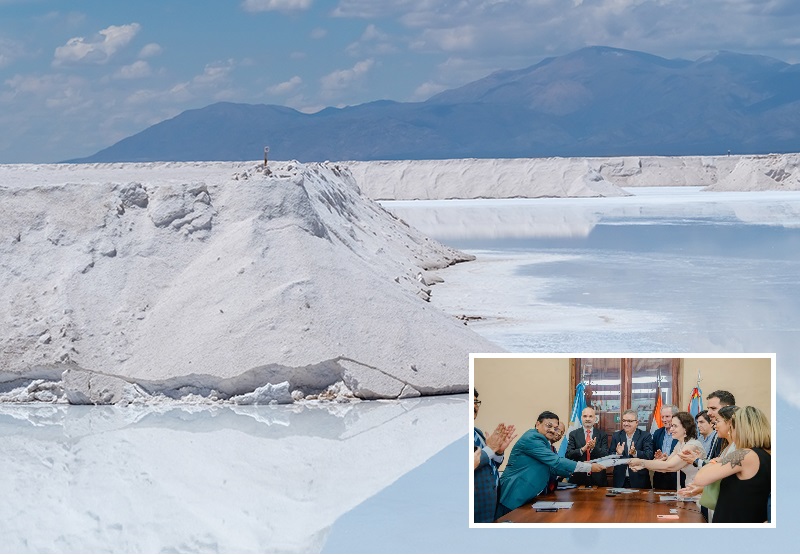
- India is undergoing a green energy transition where it requires an adequate amount of lithium and India is securing the supply and also having more control over the resource crucial for its technological and industrial future.
- India views Argentina as an important entry point to increasing its footprint in Latin America, which has traditionally had limited Indian influence because of geographical and strategic obstacles.
- India must intensify its diplomatic push by establishing more missions, expanding trade, and projecting itself as a trustworthy economic and strategic ally.
India and Argentina took an important step towards ensuring a secure supply of lithium, a mineral as precious as oil is today in the global pursuit of clean energy. On 15 January 2024, the two nations signed a deal under which India’s Khanij Bidesh India Limited (KABIL) would explore and develop the lithium deposits in Argentina’s Catamarca province. On 18 Feb 2025, the agreement, reached with Argentina’s state mining firm CAMYEN SE, provides India with five lithium-bearing brine blocks spanning approximately 15,703 hectares. For India, it’s not simply another cross-border alliance—this is a critical step to get its hands on resources essential for its rapidly expanding electric vehicle (EV) market and renewable energy sector.
India is under a green energy transition where it requires an adequate amount of lithium and India by going in directly as a mining partner, India is not only pre-emptively securing supply, but also having more control over the resource crucial for its technological and industrial future. But this deal on lithium is only part of the larger economic and strategic engagements emerging between India and Argentina. Within the last year, both nations have signed several Memorandums of Understanding (MoUs) in various sectors.
India’s Oil and Natural Gas Corporation Videsh Limited (OVL) and YPF of Argentina signed on 3rd February 2023 an agreement for oil and gas cooperation. This cooperation provides India with the opportunity to venture into Argentina’s oil and gas industry, diversifying its energy basket. Indian chemical firm CHEMEXCIL also signed a Memorandum of Understanding with CAPQ of Argentina in the chemical sector.
Argentina is significant to India because it has other precious mineral resources, defence and agricultural markets. India has large copper and gold reserves and is seeking opportunities to enter into additional agreements in these areas. Argentina also has a special investment policy, the Large Investment Incentive Regime (RIGI), which has made Indian investment in Argentina possible. This model also offers a chance for another expansion, especially within India’s technology sector. Such firms as Tata Consultancy Services (TCS) have already begun to push into the Argentine market.
India’s lithium agreement with Argentina is not merely about locking up a mineral—it’s about defining the destiny of India’s energy sovereignty. By making the strategic investment in Argentina, India is setting itself up for a secure and long-term source of key resources that will fuel its clean energy dreams. As the two countries build on their relationship across various sectors, this alliance will become a template for how developing economies can work together to foster mutual growth and stability.
India views Argentina as an important entry point to increasing its footprint in Latin America, which has traditionally had limited Indian influence because of geographical and strategic obstacles. By developing closer relations with Argentina, India aims to forge new trade and diplomatic opportunities in the continent.
One of India’s greatest challenges in Latin America is its relatively poor trade turnover in the region. In contrast to China, which has entrenched itself strongly in the economies of Latin America through investment and infrastructure developments, Indian economic engagement has been weak. The other obstacle is India’s limited diplomatic representation—there are just a few Indian embassies and trade missions in all of Latin America, which complicates the development of robust partnerships.
To make a difference, India must intensify its diplomatic push by establishing more missions, expanding trade, and projecting itself as a trustworthy economic and strategic ally. This will not be overnight, but through steady engagement, India can slowly build a more assertive role in the region.
One of the strengths India possesses is that it is a leader of the Global South. Latin America and India have convergent interests as emerging economies aspiring for a more equitable international order. India’s recent “Voice of the Global South Summit” consolidated its image as a leader of emerging economies, making it a natural ally for Latin American countries. This convergence of identity provides India with a special diplomatic advantage, enabling it to foster trust and cooperation that transcends trade and investment alone.
Aayush Pal is a freelance writer on contemporary geopolitical developments. The views expressed in his work are entirely his own.
